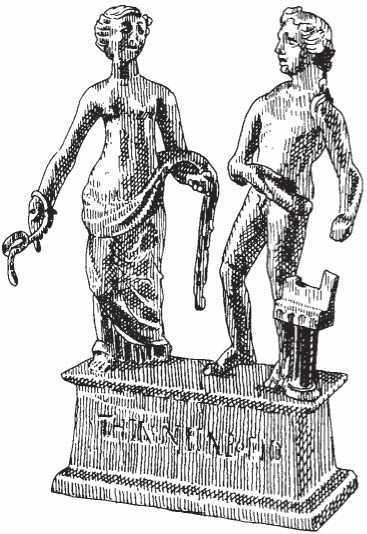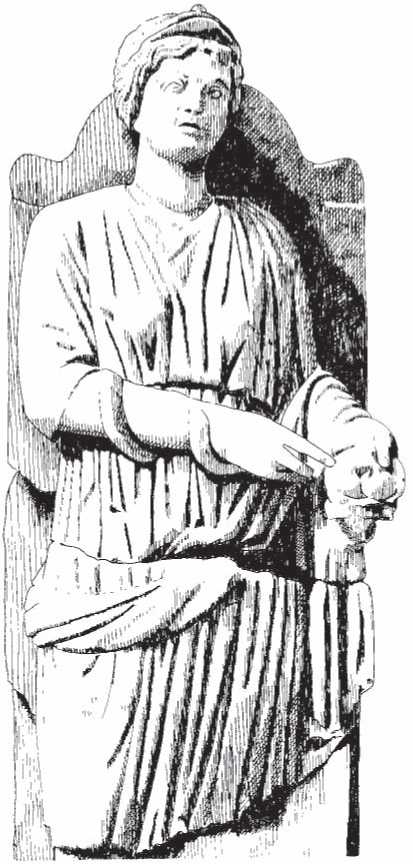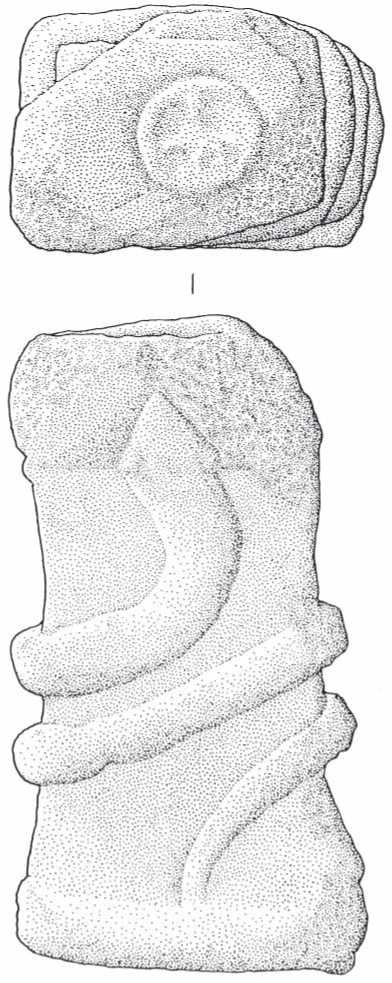In Celtic symbolism, the snake represented concepts evoked by its particular properties: snakes are essentially earthbound creatures who can slide in and out of impossibly narrow crevices in rocks and disappear below ground. Their carnivorous nature and the venom of some species must have led to their being regarded with fear and awe. The Old Testament vilifies snakes, linking Eden's serpent unequivocally with evil, condemned by God to eat the dust of the earth and to be shunned by all other creatures because of its sullying of humankind. Snakes possess the curious habit of sloughing their skin several times a year, being apparently 'reborn' in the process. They are fertile creatures: the male has a multiple penis, and the female gives birth to a prodigious number of young. Moreover, the very physical shape of the snake evokes the image of the phallus. Finally, the sinuous, rippling movement of the reptile as it flows along the ground has a resemblance to water and the river meandering through the meadowland. All these aspects of the snake stimulated a complex symbolism: to the Celts, it could represent the underworld, death, healing, renewal and fertility. It is interesting that the serpent played a similarly composite role in classical religion: the healer-god Asklepios/Aesculapius had a snake emblem, and he combined his curative function with a chthonic dimension.97
The serpent-goddesses
In the iconography, the snake is frequently the companion of a goddess, who herself has a clear identity as a spirit of fecundity, abundance or healing (figure 8.17). The Celto-Germanic mother-goddesses were invoked on dedicatory stones decorated with the image of a serpent curled round a tree (very like Satan in the Garden of Eden): this has been interpreted as a symbol of the Tree of Life, protected by the snake98 who, like the tree itself, bridged the gulf between the upper and lower worlds. Both the tree and the snake were perceived to emerge from below ground to the upper air.
Several of the healer-goddesses possessed snake attributions or companions which must have reflected the rebirth aspect of curative cults. Visitors to the Burgundian sanctuary of Mavilly worshipped a goddess with serpents and a torch, the latter perhaps evocative of light and thus clear vision, at a shrine frequented by pilgrims with eye disease.99 Sirona was venerated with her consort Apollo at the important healing sanctuary of Hochscheid near Trier,

Figure 8.17 Bronze group of Apollo and Sirona, with a snake encircling the goddess's arm, Malain, Burgundy. Paul Jenkins.
Where her cult image represents her as a dignified, serene woman wearing a long robe and a diadem. She carries a bowl containing three eggs in one hand, and around her arm is entwined a serpent which reaches out its head to the eggs (figure 8.18). Here Sirona was clearly perceived not simply as a healer but also as a divinity of fertility and rebirth.100 Her snake imagery is repeated on a bronze group depicting Sirona and Apollo and dedicated to them at Malain in Burgundy (figure
8.17): again, the serpent twists itself around the goddess's wrist.101 Interestingly, another healing spring-goddess, Damona, worshipped with Apollo Moritasgus at Alesia, seems equally to have combined roles of healing and fertility: all that remains of Damona's cult image is a stone head crowned with ears of corn and a snake-encircled hand.102
The curative cult establishments, built at the sites of sacred springs, were both physically and symbolically associated with water, and this may be one reason for the adoption of the snake by both Sirona and Damona. Serpents and the symbolism of water occur also away from the therapeutic sanctuaries: in north Britain, an image of a local river-goddess,

Figure 8.18 Stone statue of the healer goddess Sirona, with a bowl of eggs and a serpent, second to third century AD, from a shrine at Hochscheid, Germany. Original height: c.1m 69cm. Paul Jenkins.
Verbeia, spirit of the river Wharfe, was venerated at Ilkley, and is represented by a stone figure of a woman grasping two snakes, which fall in rigid zigzag movements from her hands.103
The ram-horned serpent
This extraordinary product of the Celtic imagination is found in the iconography of north-west Europe both before and during the Roman period. The image is of a serpent, its head in the form of a ram with curling horns. The idea seems to have been to enhance the symbolism of the snake, a chthonic and regenerative motif, as we have seen, by the addition of an unnatural element. Horns represented force and, because of their shape and their association with bulls, billy-goats and rams, virility and the essence of male fertility. In addition, the ram was an important emblem of fecundity in classical religious imagery. As was the case with the triple-horned bull, the ram-horned snake was a cult image which broke through the confines of naturalism and formed an intensely potent composite symbol.
On the Gundestrup Cauldron, the ram-horned snake occurs three times, once with the wheel-god, once at the head of a Celtic army and once in the company of the antlered god (see p. 147). An examination of the abundant iconography of the Romano-Celtic period in north-east Gaul demonstrates that this snake was above all the associate of Cernunnos, the stag-god. Indeed, it is possible to trace a representation of the god and his horned snake back to the fourth century BC, when the north Italians of Camonica Valley carved on the rocks a huge antlered figure with torcs and a serpent, the two major attributes of Cernunnos.104 In Romano-Celtic Gaul, the antlered god is depicted as very close to his serpentine companion: on a bronze image at Etang-surArroux in Burgundy and on a stone sculpture at Sommerecourt (Haute-Marne), the body of Cernunnos is encircled by a pair of horned snakes which feed from fruit and corn-mash held in vessels on the god's lap. It is interesting that there is another stone from the same site which represents a goddess with a horned serpent, again eating from a bowl of food: she has a cornucopia and a pomegranate, both potent classical fertility motifs.105 Again, at Yzeures-sur-Creuse (Indre-et-Loire), a carving depicts a youth whose ram-horned snake twines around his legs and rests its head against his stomach.106 But this close affinity between antlered god and horned serpent reaches its climax in a portrayal at Cirencester in Gloucestershire (figure 7.18), where Cernunnos's body is merged with those of two ram-horned snakes which replace his own legs and rear up on each side of his head to eat the fruit or corn grains clustered by his ears.107 The symbolism on a stele at Vendoeuvres (Indre) is slightly different: here Cernunnos is flanked by two human-headed snakes, thus reversing the transmogrification shown by the antlered god himself.108
Cernunnos is a peaceful god of nature and fruitfulness: his snakes appear to reflect similar qualities and perhaps intensified the god's role as a lord of renewal or rebirth. Other deities were also, on occasion, accompanied by these ram-horned snakes: the Celtic Mars, a beneficent healer and combatter of barrenness and disease rather than a warrior, was depicted with these composite reptiles. He appears, on a carving at the curative sanctuary of Mavilly (Cote d'Or), as an armoured soldier, bearing a Celtic shield and a spear. He is accompanied by a goddess who rests her hand on his shield, and by the side of his spear-shaft, a ram-horned snake rears up from the ground.109 Far away from Burgundy, at Southbroom in Wiltshire, a hoard of bronze figurines included a statuette of a local Mars grasping two large ramhorned snakes by their necks.110 The Celtic Mercury, too, adopted this hybrid creature, again perhaps as a promoter of healing and fertility: at Beauvais (Oise), the classical-looking image of Mercury is belied by the ram-horned snake carved on each side of the stone.111 At the curative establishment of Neris-les-Bains (Allier), the Gaulish Mercury sits, like Cernunnos, while a huge ram-horned serpent reposes with its head in his lap; the god is accompanied by a nymph-like goddess, the spirit of the spring.112
The ram-horned snake was occasionally a companion of the sky-gods: its association with the wheel-god (a solar divinity) on the Gundestrup Cauldron has already been noted. This is repeated far away at Lypiatt in Gloucestershire (figure 8.19), where a Romano-Celtic devotee set up an altar to the sun-god on which were carved a solar wheel and a ram-horned snake.113 It is well established that the Celtic sun-god possessed links with fertility, healing, death and resurrection,114 and it is probable that the snake was chosen as a companion of the sun-god precisely because much of the symbolism associated with it was envisaged as relevant to the solar cult. It is worth noting that conventional snakes are often associated with the Celtic sky-sun-god.115
The serpent of the underworld
The association of the celestial powers with the symbolism of the horned snake has just been discussed. But in other iconography of the Celtic sky-god, the snake appears to play a different role, primarily as a chthonic symbol of the negative, dark forces of the underworld. The sculptured group on the summit of Jupiter-giant columns has been mentioned earlier in this chapter, when the cults related to horses were being considered (pp. 207-9). The iconography consists of a sky-horseman, armed with a thunderbolt and (sometimes) a solar shield, whose horse rides down a 'giant', semi-human monster whose legs are

Figure 8.19 Stone altar encircled by ram-horned snake, Romano-Celtic Lypiatt Park, Gloucestershire. Height: 15cm. Nick Griffiths.
Replaced by serpents (figure 8.7). The artistic theme may owe something to classical imagery where, in the battle between the Olympian deities and the Titans of Earth, the chthonic giants are depicted with serpent-limbs.116 The Celtic giant is huge, an earthbound creature, its contorted facial expression evocative of its stress and anguish, and its snake-legs enhance its chthonic identity. The giant is subjugated by the galloping horseman, but it is clear that the iconography represents a cult that is essentially dualistic, where there is interdependence and symbiosis between the elements of sun and earth, sky and underworld. Darkness is necessary as well as light, winter as well as summer, and without death, life cannot exist. All of these seeming antitheses are embodied by the zoomorphic imagery of the columns: celestial god and chthonic giant are thus identified; horse and serpent represent the two opposing yet mutually dependent poles of the sky-god's sphere of influence. The iconography (and perhaps the symbolism as well) reminds one irresistibly of St George and the dragon.




 World History
World History









